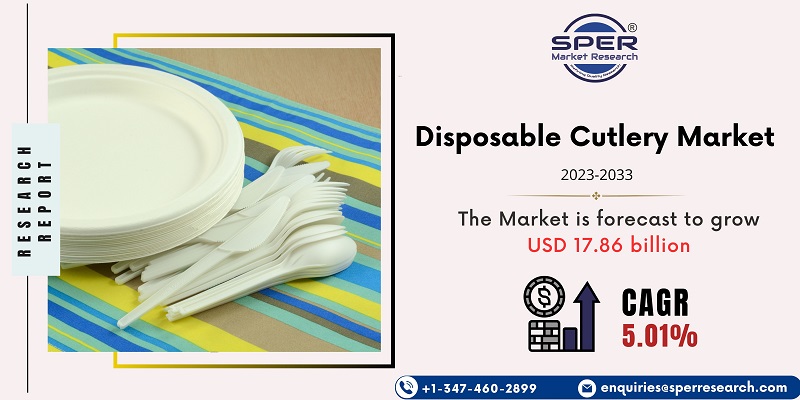
Disposable Cutlery Market Growth, Trends, Size, Demand, Revenue, Share and Future Outlook
Disposable Cutlery Market Size- By Type, By Material, By Application, By Distribution Channel- Regional Outlook, Competitive Strategies and Segment Forecast to 2033
| Published: Nov-2023 | Report ID: FMCG23116 | Pages: 1 - 224 | Formats*: |
| Category : Consumer & Retail | |||
- Biopac UK Ltd.: A new range of disposable cutlery made of renewable cornflour that can be easily disposed of through industrial composting was recently developed by Biopac UK Ltd., a renowned manufacturer and provider of environmentally friendly, plastic-free catering disposables.
- Dart Container Corporation, the leading producer of foam cups and containers worldwide, has introduced a new range of products called "Cheeky." This line includes coloured disposable flatware, paper bowls and plates and cup lids.


| Report Metric | Details |
| Market size available for years | 2019-2033 |
| Base year considered | 2022 |
| Forecast period | 2023-2033 |
| Segments covered | By Type, By Material, By Application, By Distribution Channel |
| Regions covered | North America, Asia-Pacific, Latin America, Middle East & Africa and Europe |
| Companies Covered | Anchor Packaging, Apollo Funds, Biopak, D&W Fine Pack, Dart Container Corporation, DOpla S.p.A., Goldplast, Hotpack Global, Huhtamaki, and Pactiv Evergreen, Others |
- Airlines and Rail Services
- Eco-conscious Consumers
- Educational Institutions
- Event Planners
- Food Manufacturers
- Food Service Businesses
- Healthcare Facilities
- Office Spaces
- Retailers
- Others
| By Type: |
|
| By Material: |
|
| By Application: |
|
| By Distribution Channel: |
|
- Global Disposable Cutlery Market Size (FY’2023-FY’2033)
- Overview of Global Disposable Cutlery Market
- Segmentation of Global Disposable Cutlery Market By Type (Fork, Knife, Spoon)
- Segmentation of Global Disposable Cutlery Market By Material (Plastic, Wood)
- Segmentation of Global Disposable Cutlery Market By Application (Commercial, Households)
- Segmentation of Global Disposable Cutlery Market By Distribution Channel (B2B, Convenience Stores, Online Retail, Supermarkets and Hypermarkets, Others)
- Statistical Snap of Global Disposable Cutlery Market
- Expansion Analysis of Global Disposable Cutlery Market
- Problems and Obstacles in Global Disposable Cutlery Market
- Competitive Landscape in the Global Disposable Cutlery Market
- Impact of COVID-19 and Demonetization on Global Disposable Cutlery Market
- Details on Current Investment in Global Disposable Cutlery Market
- Competitive Analysis of Global Disposable Cutlery Market
- Prominent Players in the Global Disposable Cutlery Market
- SWOT Analysis of Global Disposable Cutlery Market
- Global Disposable Cutlery Market Future Outlook and Projections (FY’2023-FY’2033)
- Recommendations from Analyst
1.1. Scope of the report1.2. Market segment analysis
2.1. Research data source2.1.1. Secondary Data2.1.2. Primary Data2.1.3. SPER’s internal database2.1.4. Premium insight from KOL’s2.2. Market size estimation2.2.1. Top-down and Bottom-up approach2.3. Data triangulation
4.1. Driver, Restraint, Opportunity and Challenges analysis4.1.1. Drivers4.1.2. Restraints4.1.3. Opportunities4.1.4. Challenges4.2. COVID-19 Impacts of the Global Disposable Cutlery Market
5.1. SWOT Analysis5.1.1. Strengths5.1.2. Weaknesses5.1.3. Opportunities5.1.4. Threats5.2. PESTEL Analysis5.2.1. Political Landscape5.2.2. Economic Landscape5.2.3. Social Landscape5.2.4. Technological Landscape5.2.5. Environmental Landscape5.2.6. Legal Landscape5.3. PORTER’s Five Forces5.3.1. Bargaining power of suppliers5.3.2. Bargaining power of buyers5.3.3. Threat of Substitute5.3.4. Threat of new entrant5.3.5. Competitive rivalry5.4. Heat Map Analysis
6.1. Global Disposable Cutlery Market Manufacturing Base Distribution, Sales Area, Product Type6.2. Mergers & Acquisitions, Partnerships, Product Launch, and Collaboration in Global Disposable Cutlery Market
7.1. Global Disposable Cutlery Market Value Share and Forecast, By Type, 2023-20337.2. Fork7.3. Knife7.4. Spoon
8.1. Global Disposable Cutlery Market Value Share and Forecast, By Material, 2023-20338.2. Plastic8.3. Wood
9.1. Global Disposable Cutlery Market Value Share and Forecast, By Application, 2023-20339.2. Commercial9.3. Households
10.1. Global Disposable Cutlery Market Value Share and Forecast, By Distribution Channel, 2023-203310.2. B2B10.3. Convenience Stores10.4. Online Retail10.5. Supermarkets and Hypermarkets10.6. Others
11.1. Global Disposable Cutlery Market Size and Market Share
12.1. Global Disposable Cutlery Market Size and Market Share By Type (2019-2026)12.2. Global Disposable Cutlery Market Size and Market Share By Type (2027-2033)
13.1. Global Disposable Cutlery Market Size and Market Share By Material (2019-2026)13.2. Global Disposable Cutlery Market Size and Market Share By Material (2027-2033)
14.1. Global Disposable Cutlery Market Size and Market Share By Application (2019-2026)14.2. Global Disposable Cutlery Market Size and Market Share By Application (2027-2033)
15.1. Global Disposable Cutlery Market Size and Market Share By Distribution Channel (2019-2026)15.2. Global Disposable Cutlery Market Size and Market Share By Distribution Channel (2027-2033)
17. Company Profile16.1. Global Disposable Cutlery Market Size and Market Share By Region (2019-2026)16.2. Global Disposable Cutlery Market Size and Market Share By Region (2027-2033)16.3. Asia-Pacific16.3.1. Australia16.3.2. China16.3.3. India16.3.4. Japan16.3.5. South Korea16.3.6. Rest of Asia-Pacific16.4. Europe16.4.1. France16.4.2. Germany16.4.3. Italy16.4.4. Spain16.4.5. United Kingdom16.4.6. Rest of Europe16.5. Middle East and Africa16.5.1. Kingdom of Saudi Arabia16.5.2. United Arab Emirates16.5.3. Rest of Middle East & Africa16.6. North America16.6.1. Canada16.6.2. Mexico16.6.3. United States16.7. Latin America16.7.1. Argentina16.7.2. Brazil16.7.3. Rest of Latin America
17.1. Anchor Packaging17.1.1. Company details17.1.2. Financial outlook17.1.3. Product summary17.1.4. Recent developments17.2. Apollo Funds17.2.1. Company details17.2.2. Financial outlook17.2.3. Product summary17.2.4. Recent developments17.3. Biopak17.3.1. Company details17.3.2. Financial outlook17.3.3. Product summary17.3.4. Recent developments17.4. D&W Fine Pack17.4.1. Company details17.4.2. Financial outlook17.4.3. Product summary17.4.4. Recent developments17.5. Dart Container Corporation17.5.1. Company details17.5.2. Financial outlook17.5.3. Product summary17.5.4. Recent developments17.6. DOpla S.p.A.17.6.1. Company details17.6.2. Financial outlook17.6.3. Product summary17.6.4. Recent developments17.7. Goldplast17.7.1. Company details17.7.2. Financial outlook17.7.3. Product summary17.7.4. Recent developments17.8. Hotpack Global17.8.1. Company details17.8.2. Financial outlook17.8.3. Product summary17.8.4. Recent developments17.9. Huhtamaki17.9.1. Company details17.9.2. Financial outlook17.9.3. Product summary17.9.4. Recent developments17.10. Pactiv Evergreen17.10.1. Company details17.10.2. Financial outlook17.10.3. Product summary17.10.4. Recent developments17.11. Others
SPER Market Research’s methodology uses great emphasis on primary research to ensure that the market intelligence insights are up to date, reliable and accurate. Primary interviews are done with players involved in each phase of a supply chain to analyze the market forecasting. The secondary research method is used to help you fully understand how the future markets and the spending patterns look likes.
The report is based on in-depth qualitative and quantitative analysis of the Product Market. The quantitative analysis involves the application of various projection and sampling techniques. The qualitative analysis involves primary interviews, surveys, and vendor briefings. The data gathered as a result of these processes are validated through experts opinion. Our research methodology entails an ideal mixture of primary and secondary initiatives.



Frequently Asked Questions About This Report
PLACE AN ORDER
Year End Discount
Sample Report
Pre-Purchase Inquiry
NEED CUSTOMIZATION?
Request CustomizationCALL OR EMAIL US
100% Secure Payment






Related Reports
Our Global Clients
Our data-driven insights have influenced the strategy of 200+ reputed companies across the globe.




















